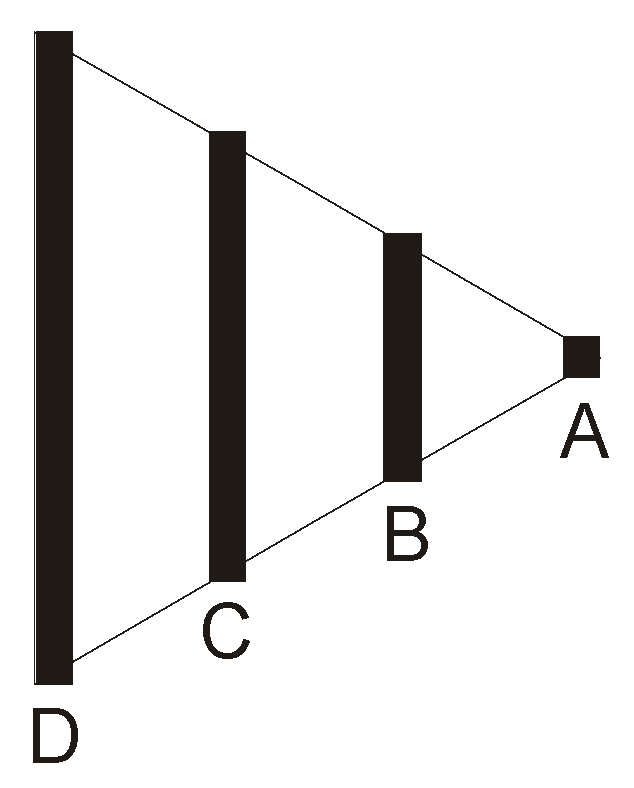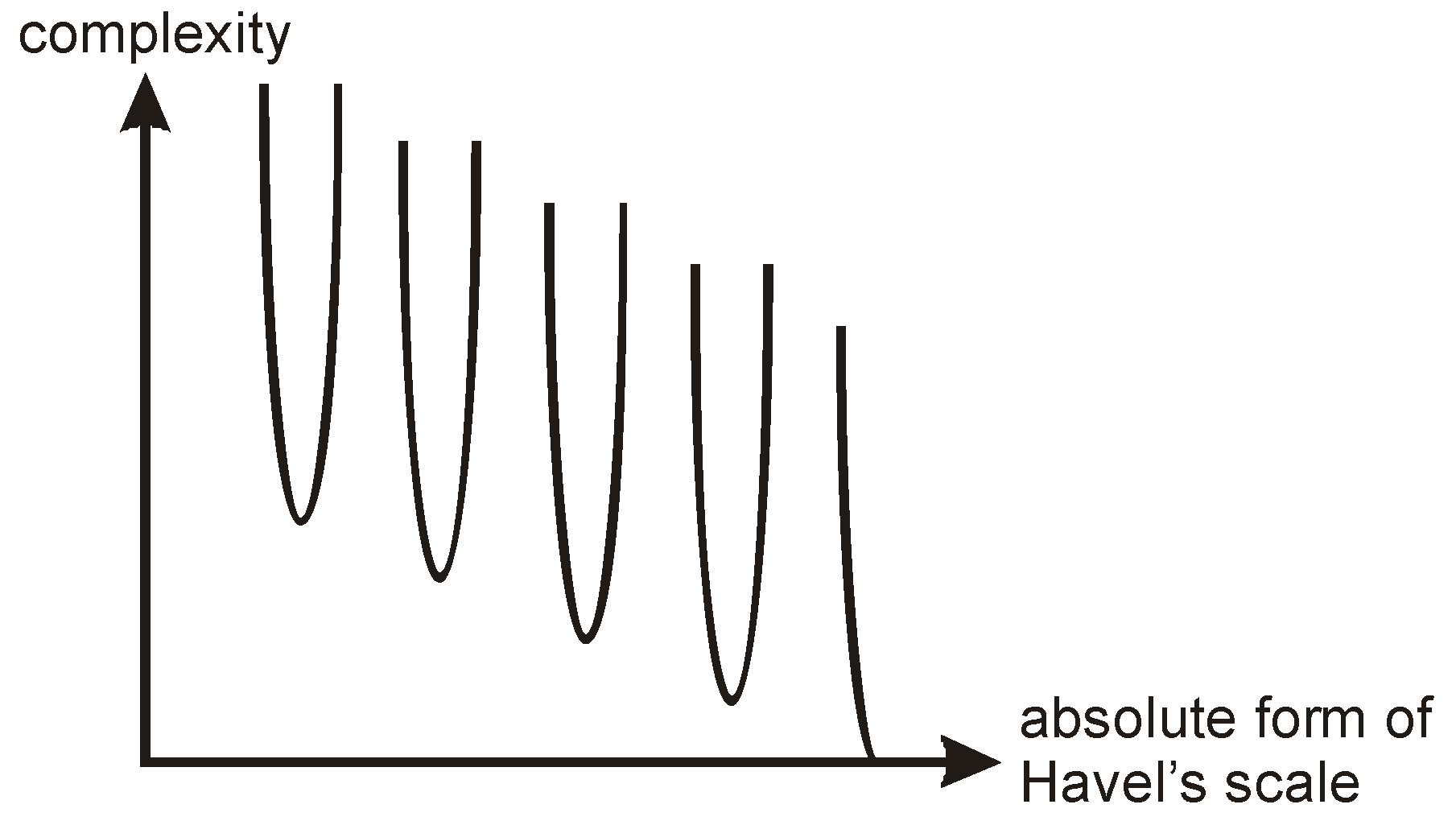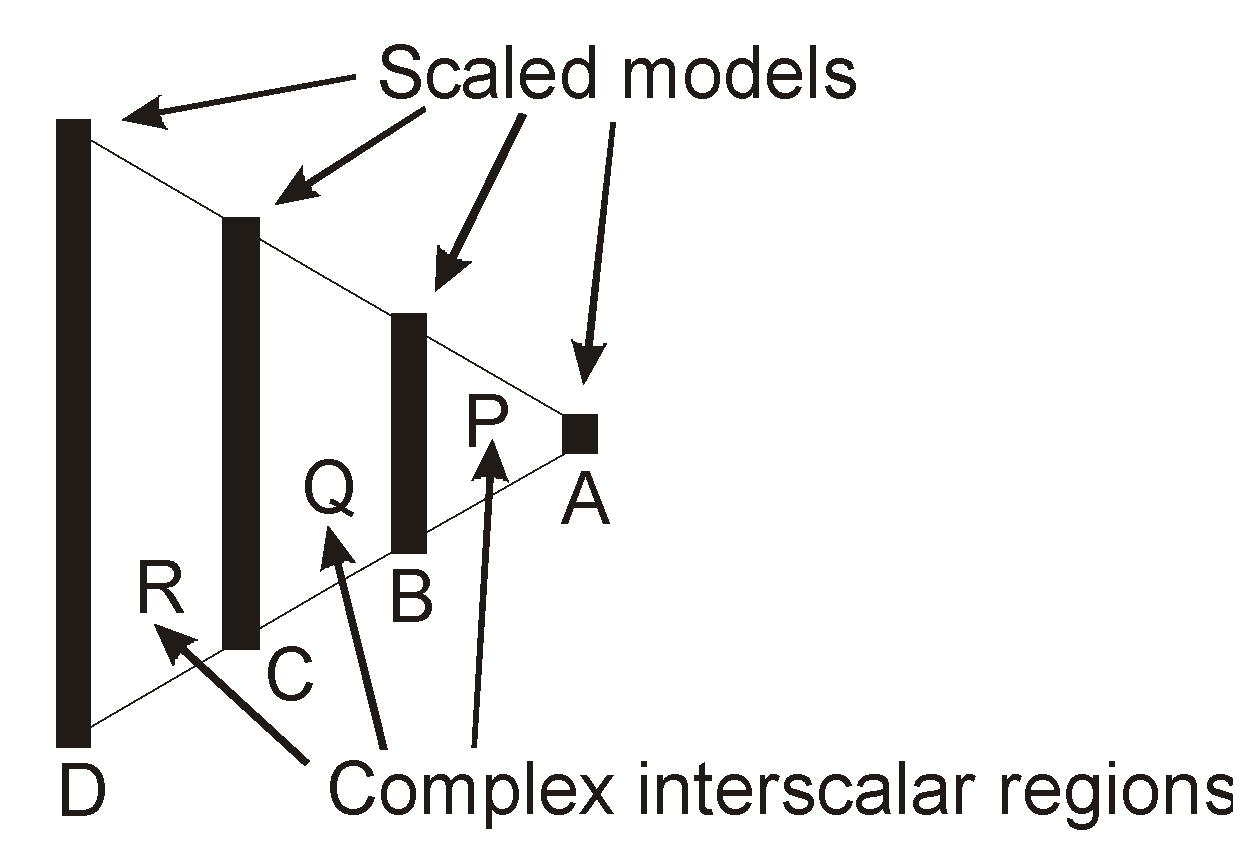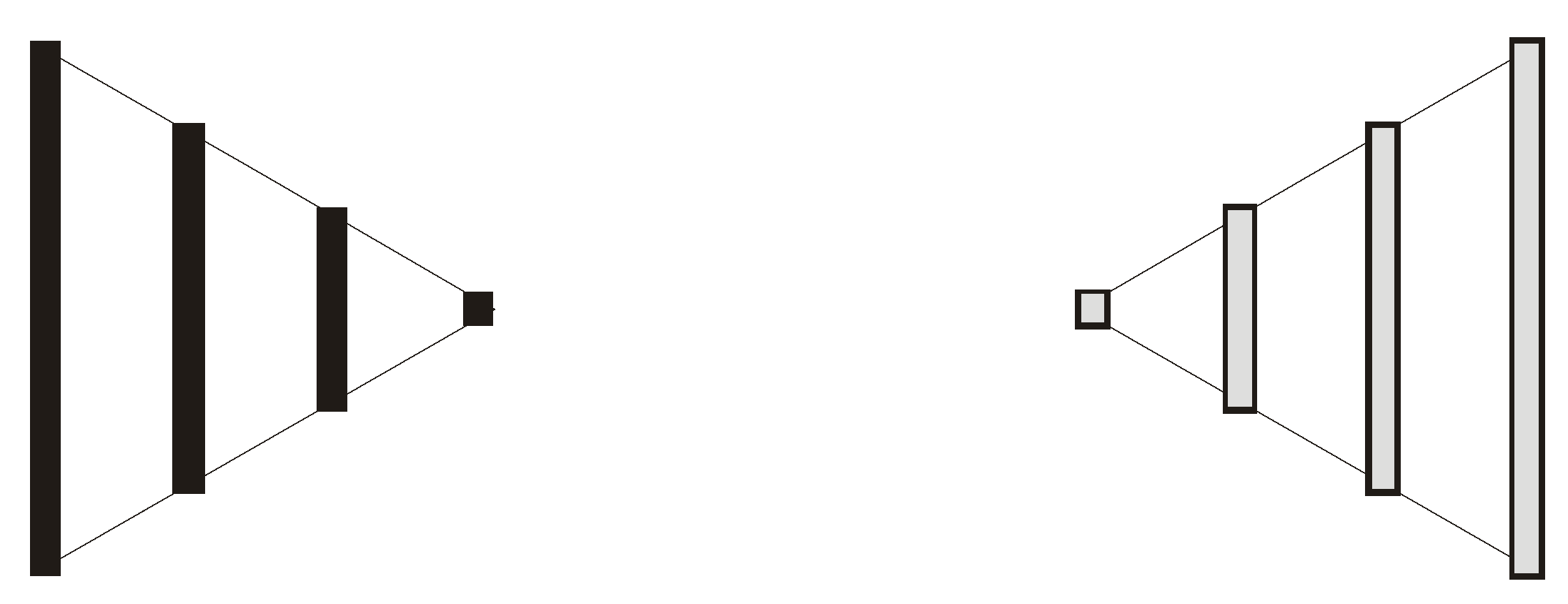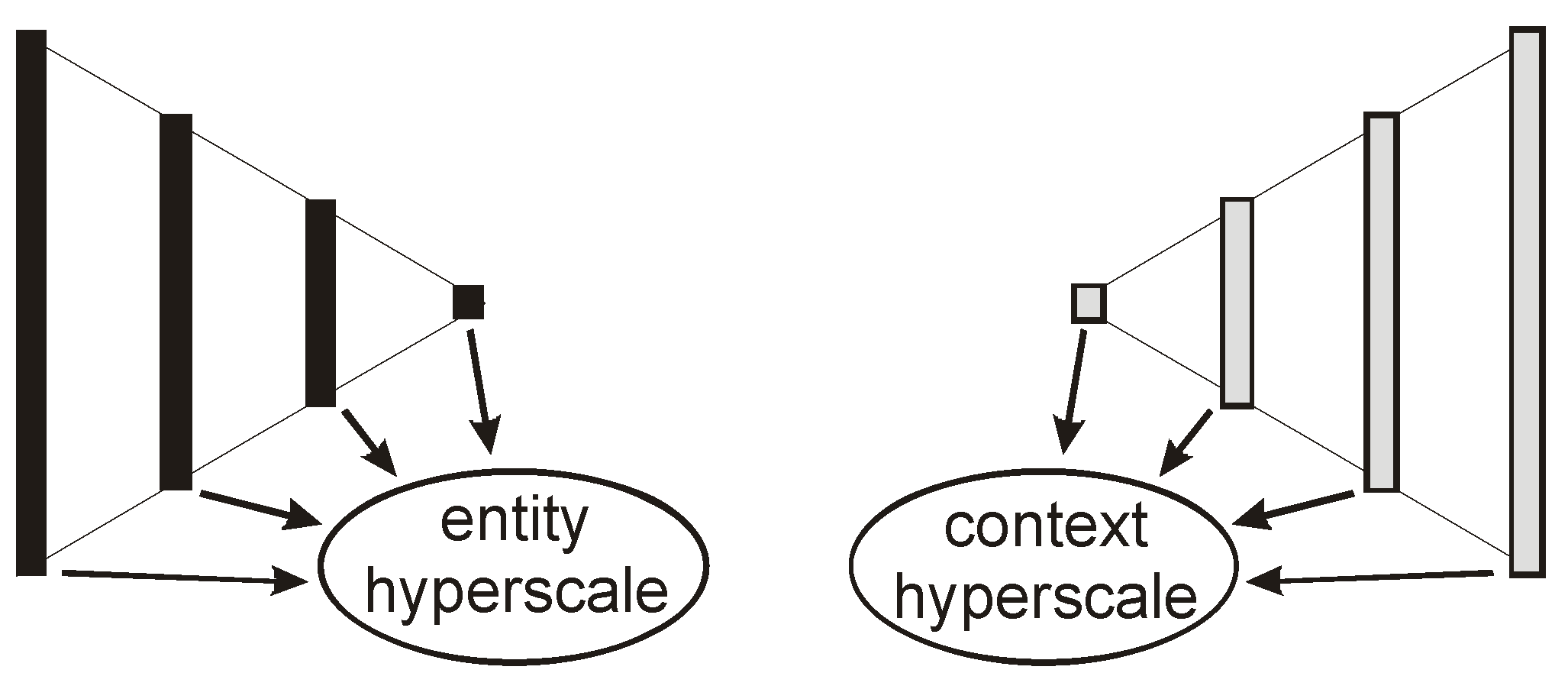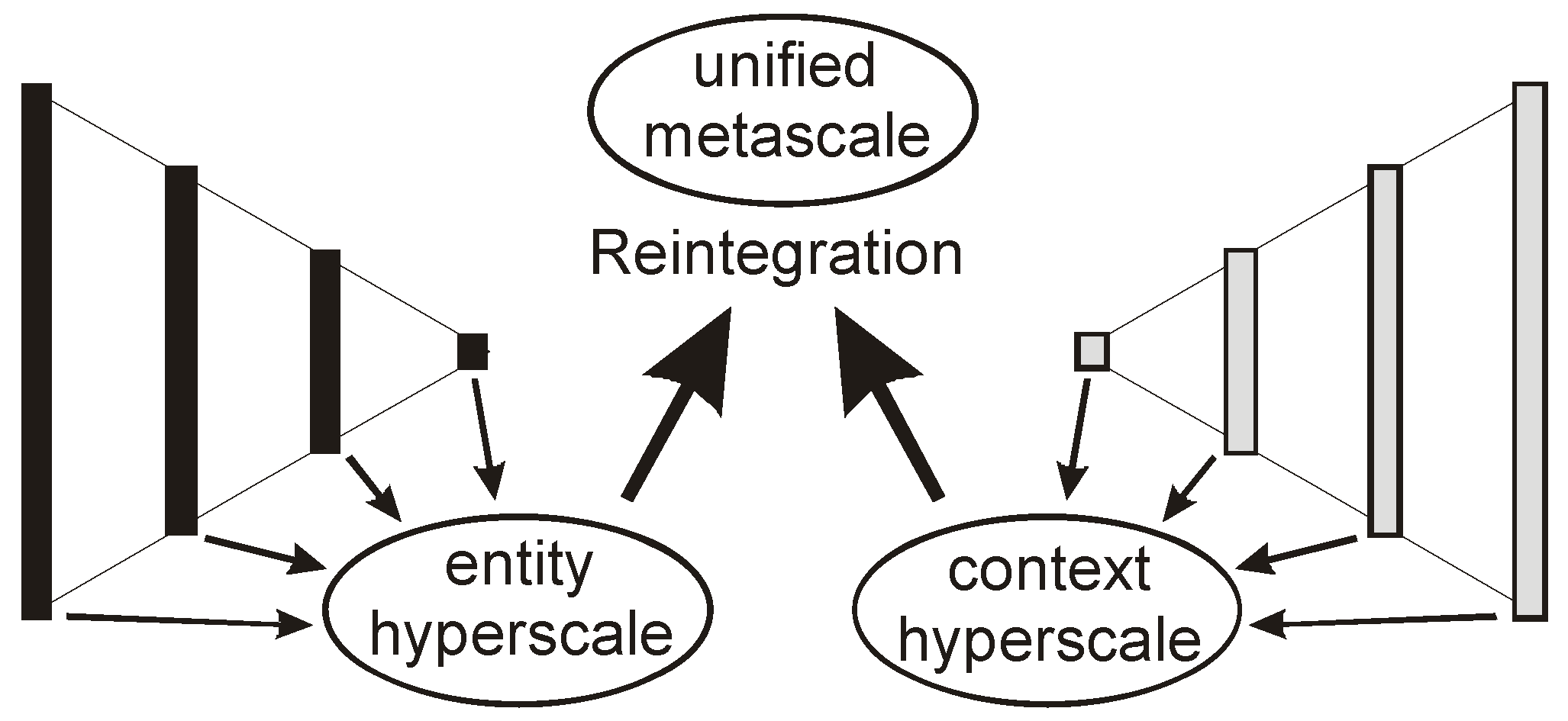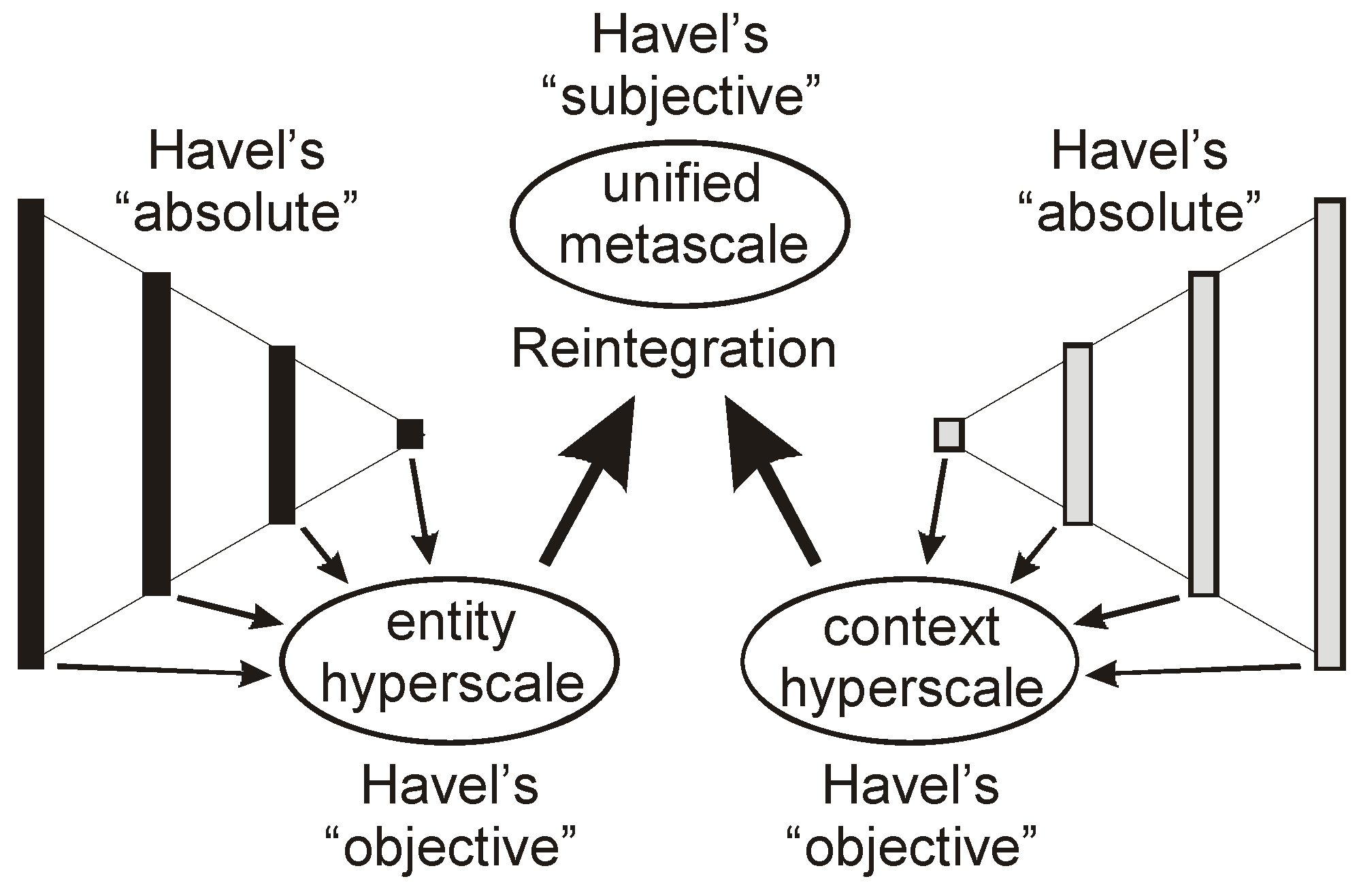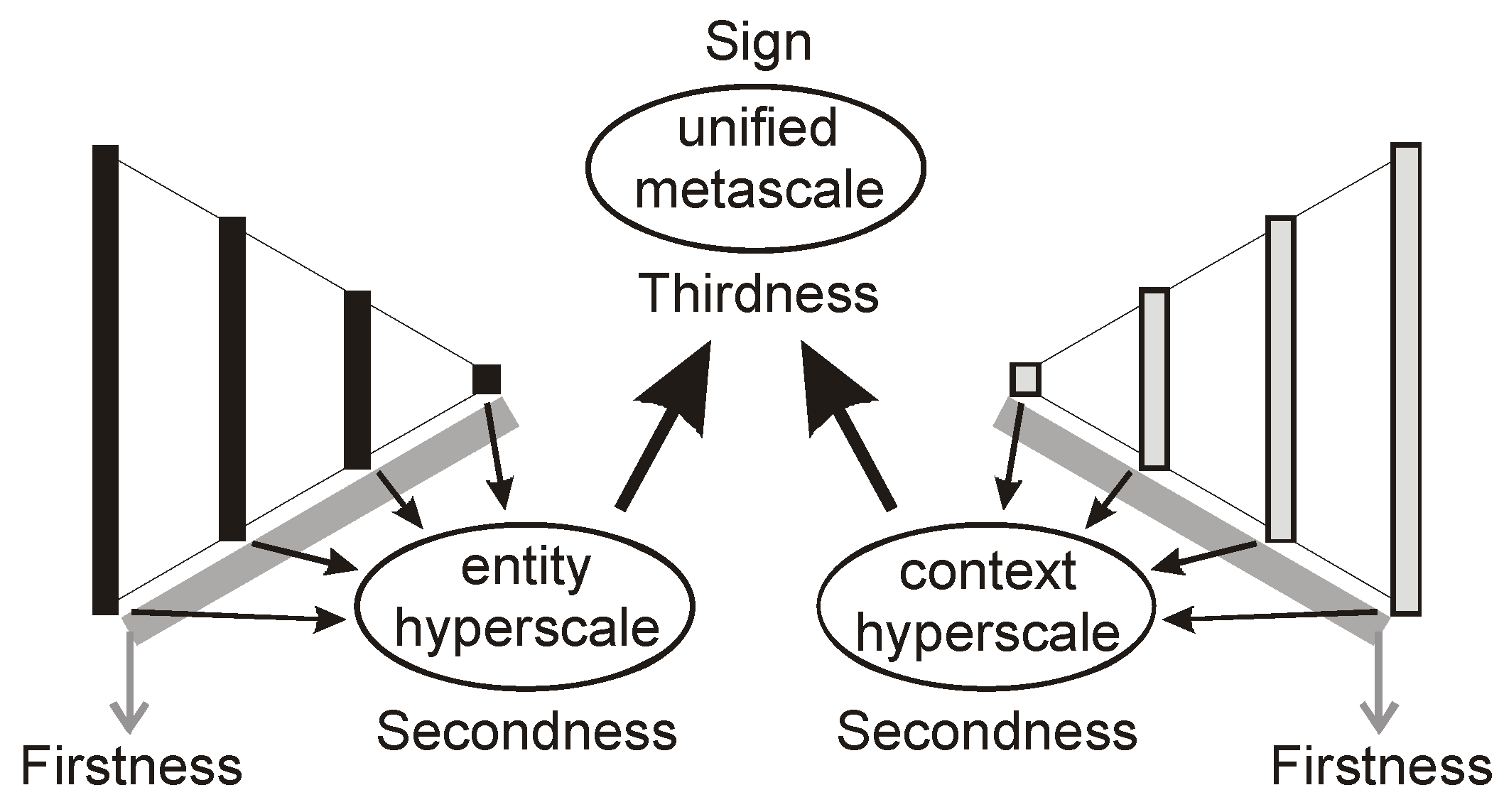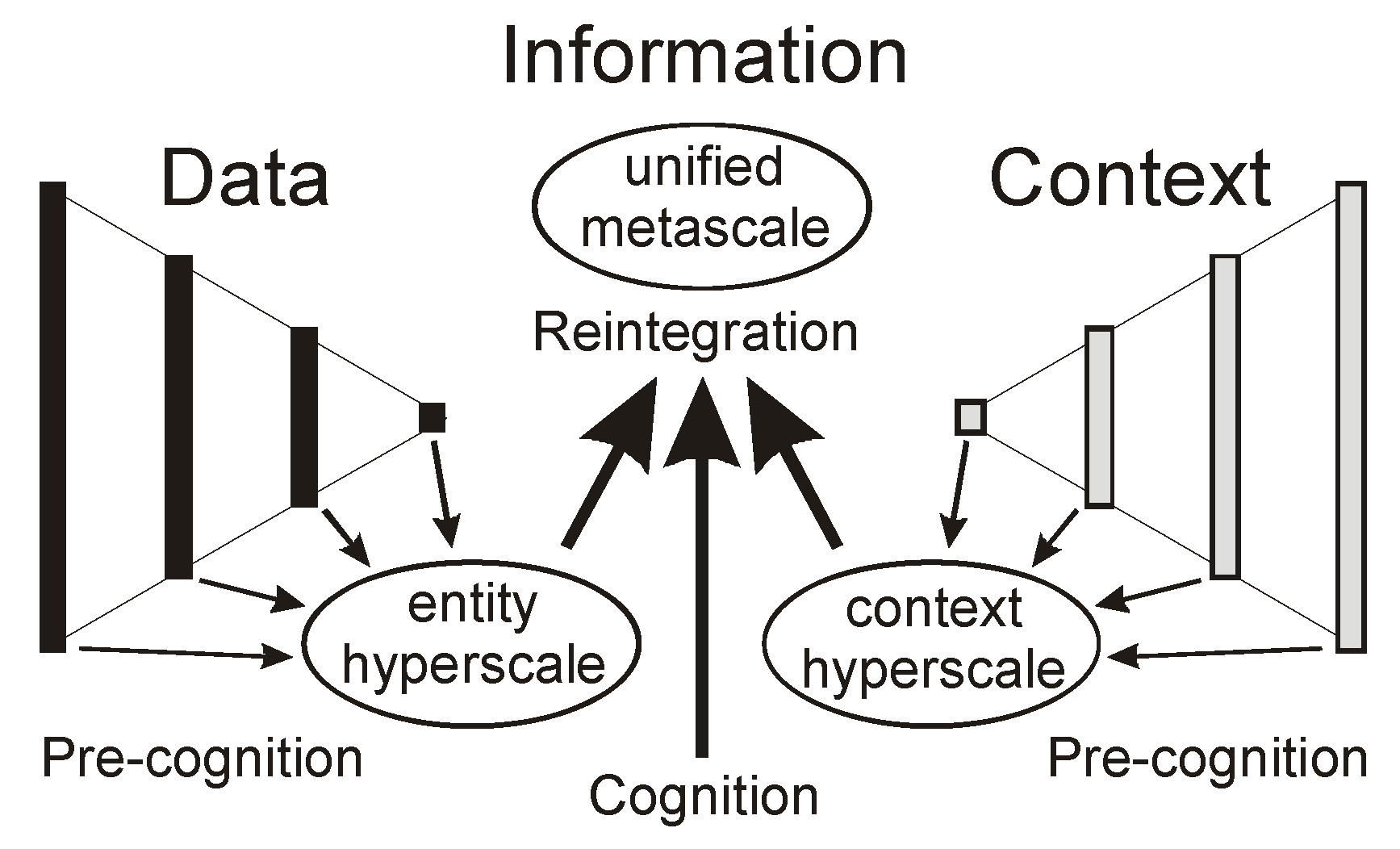1. Introduction
Nature tends towards hierarchical relationships. Unfortunately, conventional views of hierarchy do not provide an all-inclusive representation of the properties of a hierarchical system. Either we are restricted to a representation in which differently sized entities are nested within each other (e.g., atoms, molecules, cells… called a scalar or compositional hierarchy by Salthe [
1]), or one in which there is no simple extant link between the different descriptive levels of the system (e.g., physics, chemistry, biology… called a specification or subsumption hierarchy by Salthe [
1]). The situation is complicated by the pragmatic tendency of evolution to scavenge prior existing features in creating new ones, and consequently biology does not uniquely exhibit hierarchical configurations. For example, “What serves for thermoregulation is re-adapted for gliding; what was part of the jaw becomes a sound receiver; guts are used as lungs and fins turn into shovels. Whatever happens to be at hand is made use of” [
2]. Consequently, although we believe that the Nature tends towards the hierarchical relationships we describe, this may not always be apparent in the results of evolution. Gilaie-Dotan
et al. [
3], for example, have demonstrated non-hierarchical functioning in the human cortex. A second aspect is that massive information processing, as in the brain, is faster in paralleled structures. This leads to the heterarchical character of neural networks, although the compression of parallel processing to the serial output required for muscle action takes place through hierarchical structures. Dodig-Crnkovic and Giovagnoli [
4] have described Nature as a hierarchically organized network of networks, which corresponds to our own viewpoint.
Salthe has published extensively on the concept of hierarchy (see, for example, [
1]). While he has before now expressed to the authors that hierarchy is a human mental construct, devoid of any other reality, we note that in [
5] with Eldredge, for example, he takes a more ontological position (in reference to Salthe’s 1975 book, among other references, they state that “The several concrete proposals of this kind…have for the most part been constructed only from an epistemological perspective”). Hierarchy permits the generation of simple representations of complex informational domains, thus supporting faster survival-promoting reactions to environmental stimuli, and as such it is a primary cognitive mechanism used by all living systems, not just humans. This, of course, raises the question of the validity of representation in information theory. Our own position is clearly that representation is a necessary “computational” device for survival and therefore for evolution itself. Any other position would negate the importance of hierarchy in Nature. As Dodig-Crnkovic and Giovagnoli [
4] comment in their discussion of connectionist approaches, “…it is correct that there is ‘no computation without representation’”.
We present a radically different representation of hierarchy from Salthe’s two variants—a
model hierarchy—which is on a higher organizational plane when compared to the two preceding representations, and which is in fact the parent of both of them [
6]. It is worth noting that this formulation of a model hierarchy automatically includes heterarchy in its purview, as individual model layers can be formulated as neural networks, for example.
Current approaches to the definition of information lack attention to
this particular model-hierarchical character of Nature. Information is most often defined on the basis of order or entropy, but it is questionable whether this approach is valid for living systems, where a duality of order or entropy is prevalent [
6]. We find it parsimonious to first define information with respect to the Natural (living) hierarchy—where the greatest complications and complexity are found—and then to reduce this formulation where necessary to correspond to a simpler specific context: we will address this aspect later in the paper.
We will first look at the general properties of a model hierarchy in its context of representing a living system, and then tackle the thorny problem of external access to hierarchical scales, leading to the definition of hyperscale and the reintegrative character of metascale. Next we will look at the relationships between this formulation and the work of Ivan Havel [
7] and Charles Peirce [
8], which will lead us to a derivation of information in Natural hierarchies.
2. Hierarchical Systems
Figure 1 illustrates our general representational form of a
model hierarchy. It is vital to note that this kind of representation
is not consistent with, most particularly, a composition hierarchy. A model hierarchy is an entirely new kind of representation, which is generic to other hierarchical schemes. We cannot emphasize this enough: understanding of the way a model hierarchy “operates” requires complete disconnection from other more conventional and, at first sight, similar arrangements. We make the bold move of proposing that this representation is primarily ontological in character, as we will describe later in the paper. The different levels of such a hierarchy are NOT nested within each other, as are those of a composition hierarchy, while individual levels refer to different specifications of the described system, in a manner similar to those of a subsumption hierarchy (Salthe himself has referred to a model hierarchy as “a subsumption hierarchy constructed in terms of scale”!).
Figure 1.
The simple representation of a model hierarchy. Vertical line length indicates how much information is necessary to set up the local model.
Other hierarchical relationships for information have been previously published (e.g., recently [
9,
10]), but none of these are related to the present exposition, in that the published proposals do not have the generality of character of a model hierarchy. Most particularly, the work of Floridi (e.g., [
11]) on Levels of Abstraction is not directly relatable to the hierarchical scheme described in this paper, as he is solely referring to views of a system from outside—his Levels of Abstraction are a guide to epistemological experience rather than references to ontology, unlike the levels in a model hierarchy. A second point of disagreement, although Floridi would describe a model hierarchy as a
gradient of abstractions, is that in our representation all of the levels of the scheme are coupled together to create a self-consistent whole, and local events or structures (
i.e., generally, models and transits between them) are specifically controlled by global properties (and, of course,
vice versa). It is worth noting here Havel’s [
7] insistence that things and events are only distinguished by differences in time scale: “In the world of all scales there is no essential difference: things are just long-lasting events and events are just short-lived things, where -long- and -short- are relative with respect to our temporal scale perspective”.
Figure 2 illustrates the basic nature of a model hierarchy. It is important to note that complexity is engendered as soon as modeling is attempted; consequently, a modeled system always exists within a more-or-less complex phase space, as indicated in the figure. We do not address here the way in which a model hierarchy is instantiated or evolves, merely the form which it ultimately exhibits (the startup problem is one which besets analysis and synthesis of all kinds of scientific endeavors). We have portrayed the system in terms of a graph in
Figure 3; the most difficult aspect of this is that the graph axes are uncommon in that they are automatically nonlinear and possibly discontinuous—thus the simplification which we make in our habitual representations of a model hierarchy (e.g., as in
Figure 1). The vertical axis describes the degree of Rosennean complexity [
12] at particular locations in the phase space, while the horizontal axis is more problematic in terms of its definition (Rosen’s definition of complexity is in terms of representational incompleteness: he defines complexity as a situation which is not simulable except by application of an infinite number of different representations). Havel [
7] has characterized investigative endeavors in terms of three descriptions: he refers to
absolute,
subjective and
objective representations. We will meet all of these three later in the paper, but for the moment we will retain solely the
absolute, which, for Havel, is a purely ontological description. A further significant aspect of Havel’s work [
7] is the development of his idea of
scale. This is a purely
relative concept, which refers to the “distance” in terms of the size of a feature or event from the location in terms of “size” which is the focus of interest. We believe that the best characterization of the horizontal axis in
Figure 1 is as a combination of these two parts of Havel’s work: it is an
absolute (ontological) formulation of Havel’s
scale. It is, therefore, easy to see how a model hierarchy could be unfortunately mistaken for a composition hierarchy.
Figure 2 indicates how a survivalist tendency to promote “computational ease” creates islands of simplicity within the co-generated complex phase space of a system. These islands appear as Newtonian potential wells, and the evolution of their depth results in local complexity being “dumped” out of them and into the local phase space. The net result of evolution, therefore, is of a pair of identifiable local features: one which is a comparatively easy-to-compute simplified model, and the other which is the consequent “ecosystem” from which it has apparently “emerged”. It is clear in this scheme that the resulting extant “scales” are
not nested within each other—they are local individual emergences from the global systemic phase space. Habitually in hierarchical representation, there is a clear distinction between the hierarchy of control and the hierarchy of organization. This, however, is not the case for a model hierarchy, such as is discussed here: different hierarchical levels consist of systemic models, which can imply either control, or organization (information systems or matter-and-energy exchange), or any one of these. We believe that this model-hierarchical representation of Nature is more ontologically correct than that implied by other lower-level representations, such as a composition hierarchy, which implies the necessity for a completely new look at our presuppositions about the emergence of Nature from the big bang, and of its consequent evolution.
Figure 2.
The representation of a system in terms of a complex phase space with localized extant levels or scales which appear as Newtonian potential wells that present a simplified route to effective survivalist “computation”.
Figure 3.
A model hierarchy, indicating the different model levels A, B, C, D and the inter-scalar complex regions P, Q, R.
We will always portray a hierarchy lying on its side, as in
Figure 1, because we do not believe that in a Natural hierarchy the conventionally indicated “top” of the hierarchy has precedence or overall control. The length of the vertical lines indicates the amount of
information required to circumscribe the associated model: more complicated models require more information, and in the figure the simplest, or highest, level of the hierarchy is on the right-hand side (labeled “A”) as indicated by the line lengths. The word “information” appears somewhat awkwardly here, as we will later define information as appearing at a completely different location in a hierarchy; it is tempting to use “data” instead, but this would give a wrong impression—we will later address this question of “information” or “data” appearing in different guises in different functional locations. With the aim of consolidating this approach, it is easy to see how this representation could describe a business organization, for example, where A would be the chief executive, B the vice-executives, C the middle management and D the workforce. We must again insist that we are here talking about a
model hierarchy and
not a composition hierarchy!
Regions in between the extant models (e.g., between B and C) are complex in character. This mirrors the unexpected difficulty with an “equation” such as 1 + 1 = 2. There is no way that we can independently and logically derive the 2 from 1 + 1—fortunately, it is a result defined in number theory so we never have to! Such an “equation” is, in fact, both hierarchical and partially irreversible: given that we have moved from left to right, we then lack sufficient information to say what was initially on the left-hand side (it could well have been 1 + 1, but equally well 4 − 2 or 8/4!). The complex regions between levels of a model hierarchy are similar in character: not only is it impossible to purely logically carry out the transit between, for example, C and B in the figure, but having done so we lack sufficient information to logically return to C. This seems, at first sight, to be a trivial property, but it controls everything that takes place in a Natural hierarchy.
The complex inter-model regions have yet another important characteristic. If we consider, for example, model C in the figure, then it is clear that it is just a reduced representation of the entire system itself. The model, however, invisibly “contains” a large amount of information which is absent from its formulation (in our example of a business structure, the model C of middle management misses out most of the characteristics of the work force D which it represents). This missing (or “contained”) information is itself represented in the complex region leading up to C (by way of the globality of communications linking the work force D to and from middle management C).
Figure 3 illustrates the complicated character of a Natural hierarchy. Transit from model D to model C passes through complex region R where there is an absence of simple logical relationships. This indicates the biggest problem when dealing with a Natural hierarchy: if the inter-scalar regions are so complex (in fact, they are multiply fractal in character [
6]), then how on earth can we deal with relations between adjacent models? Possibly the most important aspect of Natural hierarchy is that knowledge of the entire system’s global properties is required to deal with local inter-scalar transit [
6].
In
Figure 3, model A is very limited, and, consequently, its “contained” information appearing in region P is very extensive. Model B is more complicated, so its “contained” information in region Q is more constrained, and so on.
Figure 4 illustrates this situation. The black lines, as before, represent the local system models; the gray regions represent the associated “contained” or “hidden” information (it is tempting to associate this “contained” or “hidden” information with the “hidden variables” found in, for example, David Bohm’s formulation of quantum theory; we believe that this association is justified). Intuitively, this set of gray regions forms a second partial hierarchy in opposition to the first one. This provides us with the general form of a Natural hierarchy [
13]. The gray complex regions in
Figure 4 (e.g., Q in
Figure 3) operate as locally constructed scaled representations of the system’s environment—regions from which their associated models (e.g., B in
Figure 3) have emerged.
Figure 4.
The relationship between the two contra-oriented hierarchies. Black lines indicate the local models; gray regions indicate their associated “contained” information.
